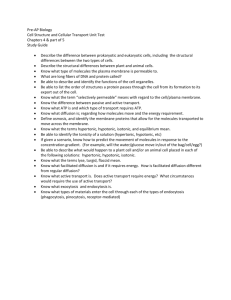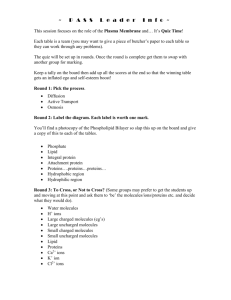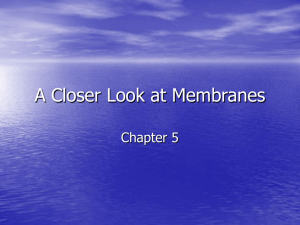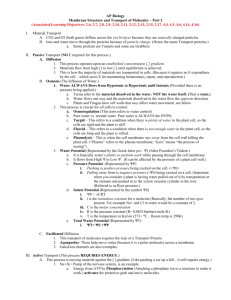Transport
advertisement
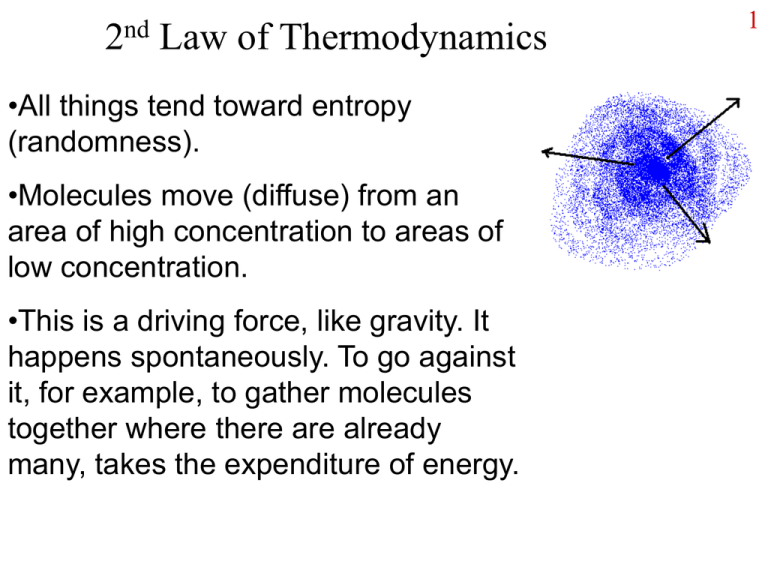
2nd Law of Thermodynamics •All things tend toward entropy (randomness). •Molecules move (diffuse) from an area of high concentration to areas of low concentration. •This is a driving force, like gravity. It happens spontaneously. To go against it, for example, to gather molecules together where there are already many, takes the expenditure of energy. 1 Type of molecule affects transport 2 • The major function of a cell membrane is to prevent substances from entering or escaping the cell. • Small molecules can pass through a lipid bilayer – Water; otherwise, no osmosis – Gases such as O2 and CO2 • Lipid molecules can – Dissolve in lipid bilayer, pass through membrane – Many antibiotics, drugs are lipid soluble • Larger, hydrophilic molecules cannot – Ions, sugars, amino acids cannot pass through lipids – Needed to provide raw materials & energy for cell. How things get in (and out) of cells • Eukaryotic cells – Have transport proteins in membrane – Have a cytoskeleton made of microtubules • Allows for receptor mediated endocytosis, phagotcytosis, etc. • Cell membrane pinches in, creates vesicle • Prokaryotic cells – Have a stiff cell wall – Can NOT carry out endocytosis – Entry of materials into cell by diffusion or transport processes ONLY. 3 Illustrations: entry into cells Only eukaryotes. Both prokaryotes and eukaryotes. http://bio.winona.msus.edu/bates/genbio/images/endocytosis.gif http://www.gla.ac.uk/~jmb17n/Teaching/JHteaching/Endocytosis/figures/howdo.jpg 4 Transport through membranes • Simple diffusion – Molecules travel down concentration gradient – Membrane is not a barrier to their passage • Facilitated diffusion – Molecules travel down concentration gradient – Cannot pass through lipid bilayer; their passage is facilitated by protein transporters • Active transport – Molecules travel against concentration gradient – Requires input of metabolic energy (ATP), transporter 5 How molecules get through the membrane http://www.rpi.edu/dept/chem-eng/Biotech-Environ/Membranes/bauerp/diff.gif 6 ABC transport systems • Include a periplasmic binding protein, a transmembrane channel, and an ATP-hydrolyzing enzyme. • High affinity binding system. • Family of related proteins. – Eubacteria, Archaea, Eukaryotes • Example of Active Transport – Requires transport protein – Requires metabolic energy http://www.ugr.es/~eianez/Microbiologia/images/06memb3.jpg 7 Group Translocation • “Straddles” facilitated diffusion and active transport. • Used by bacteria to transport various sugars. As molecule passes through the membrane, it is chemically changed. • Requires energy in the form of PEP. • Requires series of proteins • Energy brings sugar in AND activates it for metabolism. 8 Permeases • Transport proteins are often called permeases (-ase = enzyme) because they have the same properties – – – – Instead of changing a chemical, they change its location Permeases have an “active site” Permeases are specific Permeases are saturable http://cwx.prenhall.com/horton/media lib/media_portfolio/text_images/FG0 9_32.JPG 9 ATP is not always used directly in active transport • An electrochemical gradient exists across the cell membrane (membrane potential) – Positive just outside the membrane, negative within – Gradient in the form of H+ ions Maintained by the hydrolysis of ATP or by the same metabolic reactions that make ATP Powers uniports, symports and antiports 10 Uniport • Transport of a single substance • Example: transport of K+ into the cell – Against its chemical gradient, but down its electrical gradient. – (red ball = K+) – Doesn’t require energy DIRECTLY, but making the electrical gradient DOES require energy. 11 Antiport and Symport 12 www.cat.cc.md.us/.../ prostruct/u1fig6e1.html Molecules (red balls) transported against a gradient. Coupling to flow of H+ into the cell powers this.




